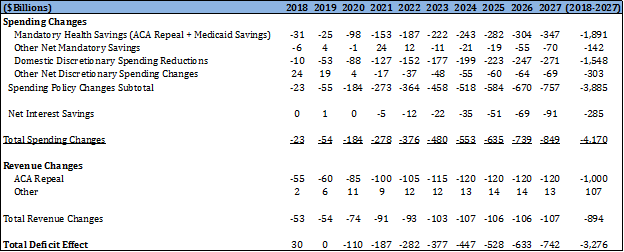Insight
July 13, 2017
What You Need to Know about CBO’s Analysis of Trump’s First Budget
Today, the Congressional Budget Office (CBO) released an analysis of the Trump Administration’s first budget. If there is a single lesson to be learned from CBO’s estimate, it’s that growth matters, and in this case it’s essentially all that matters. The Trump budget contained a few fairly large policy proposals with fairly predictable budgetary effects – repealing the Affordable Care Act sharply reduces mandatory spending as well as revenues, while large domestic discretionary spending cuts further reduce the spending side of the ledger. Combined with other policy changes of smaller orders of magnitude, these policy changes would, according to CBO, reduce the deficit by $3.3 trillion over the next decade.
Table 1: CBO’s Estimate of Major Policy Changes in Trump Budget
Importantly, the savings estimated by CBO are measured relative to a baseline deficit projection of over $10 trillion over the next decade. Put differently, according to CBO the Trump budget would still propose deficits totaling over $6 trillion over the coming decade. This finding stands in sharp contrast with the message from the administration that the budget would be balanced by 2027, and run just over $3 trillion in cumulative deficits over the coming decade. The key difference between the deficits presented in the administration’s budget and CBO’s estimates relates to the economic assumptions underlying these analyses. The administration assumed much higher growth in their budget estimates than CBO – which translates into much higher revenue. These assumptions explain away virtually all of the differences between the president’s Office of Management and Budget (OMB)’s and CBO’s budget estimates.
Table 2: Crosswalk from CBO to Administration’s Budget Estimates












